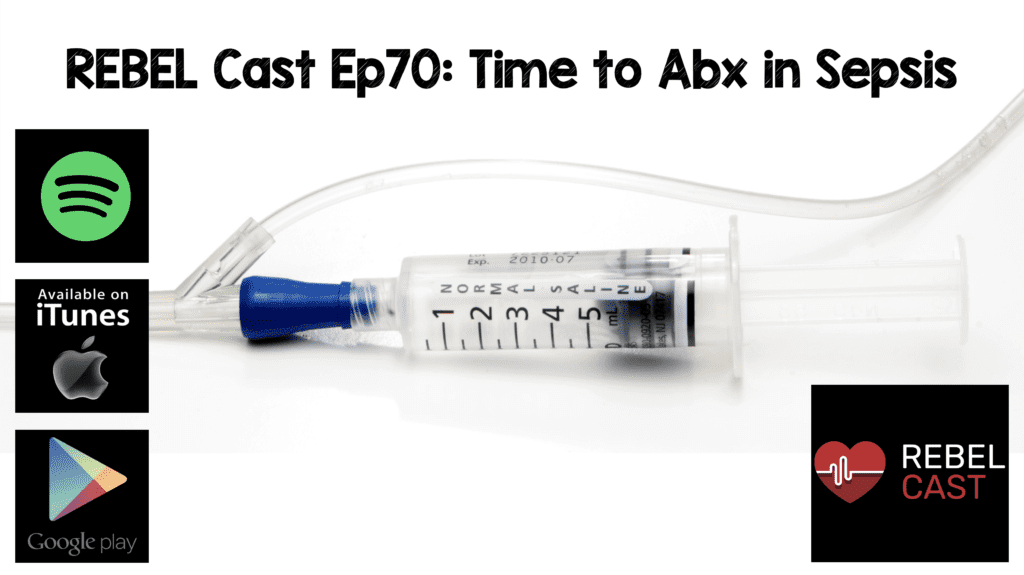
REBEL Cast Episode 70: Time to Antibiotics in Sepsis
PHANTASi (Prehospital Antibiotics against Sepsis) [1]
What They Did:
- Randomized controlled open-label trial
- 10 large regional ambulance services in the Netherlands
- Compared the effects of early administration of antibiotics in the ambulance vs usual care
- Intervention: Open-label IV ceftriaxone 2000mg in addition to usual care
- Usual Care: Fluid resuscitation and supplementary oxygen
- Sepsis Severity Definition (Based off the 2001 SSCM/ESICM/ACCP/ATS/SIS International Sepsis Definitions)
- Uncomplicated (non-severe) sepsis
- Severe sepsis = Sepsis + Organ dysfunction
- Septic shock
- Before the start of the trial, all participating EMS personnel were trained to recognize all forms of sepsis promptly
Outcomes:
- Primary: all-cause mortality at 28d
- Secondary:
- Number of misdiagnoses in patients enrolled in the study by EMS personnel
- Mortality during hospital stay and within 90d
- Length of hospital stay
- ICU admission
- Length of stay in the ICU
- Time to abx in the ED for the usual care group
- Time to abx before hospital arrival for the intervention group
- Microbiological data
- Adverse events
- Quality of life 1 month after DC via the SF-36 questionnaire
Inclusion:
- ≥18 years of age
- Diagnosed or suspected infection
- Temperature ≥38C or less than 36C
- At least one other criterion of SIRS (HR >90 BPM or RR > 20BPM or both)
Exclusion:
- Allergy to ceftriaxone or to other beta-lactam antibiotics
- Pregnant
- Suspected prosthetic joint infections
Results:
- 2698 patients enrolled
- Intervention: 1535 pts
- Usual Care: 1137 pts
- ≈37% of patients had non-severe sepsis
- ≈58% of patients had severe sepsis
- ≈4% of patients had septic shock
- Median Time to Abx:
- Intervention: 26 min (Range 19 – 34min)
- Usual Care Before EMS Training: 93 min (Range 39 – 140min)
- Usual Care After EMS Training: 70 min (Range 36 – 128min)
- 28d Mortality:
- Intervention: 120 pts (8%)
- Usual Care: 93 pts (8%)
- RR: 0.95; 95% CI 0.74 – 1.24; p = 0.78
- 90d Mortality:
- Intervention: 134pts (12%)
- Usual Care: 178pts (12%)
- RR: 0.98; 95% CI 0.80 – 1.21; p = 0.87
- Re-Admission to Hospital Within 28d:
- Intervention: 102 pts (7%)
- Usual Care: 119 (10%)
- P = 0.0004
- 28d Readmission Rate:
- Intervention: 102 pts (7%)
- Usual Care: 119 (10%)
- P = 0.0004
- No statistical differences in ICU admissions, length of hospital stay, nor in-hospital or 90d mortality
- No serious adverse events (i.e. anaphylactic shock) seen in the intervention group
Strengths:
- 1st Prospective RCT that compared the effects of early prehospital antibiotics with usual care in patients with suspected sepsis
- Independent monitoring board verified whether all serious adverse events and suspected unexpected serious adverse reactions were reported appropriately
Limitations:
- 577 pts (22%) were already on oral antibiotic therapy at randomization which may dilute the effect of earlier antibiotics on mortality
- Only ≈4% of patients had septic shock, which is the sickest patient population and the population most likely to benefit the most from earlier antibiotics. The overall 28d mortality of 8% is lower than larger randomized trials.
- Some EMS personnel purposefully opened randomization envelopes until they found an envelope instructing randomization to the intervention group which is why there were 398 more patients in the intervention group compared to the usual care group (i.e. randomization was not properly executed)
- The mortality rate in this study (i.e ≈8%) was significantly lower than the predicted mortality of 40% seen in larger epidemiological studies done in the ICU setting, meaning this patient population may not have been as sick
Discussion:
- More patients in the intervention group had positive blood cultures (35%) vs the usual care group (26%), with the majority of infections being gram positive bacteria.This could be indicative of a higher contamination risk of blood culture analysis in the prehospital setting
- Early “appropriate” antibiotic treatment is an important point to make here. I am not sure that just giving 2g of Rocephin is what I would call appropriate when the majority of patients had lung and urinary tract infections.
- Inappropriate use of antibiotics is an important question to ask. How many patients received antibiotics inappropriately?
- It is also important to realize that time to antibiotics is from triage time and not from time zero, when the infection initially started. Although this is a true statement, knowing the exact time of when an infection started is a difficult measure
- In 93% of cases an ambulance reaches the ED within 15min and has an average of 40min from dispatch call to arrival at the ED. These times may be significantly shorter than what we see in the US
Author Conclusion: “In patients with varying severity of sepsis, EMS personnel training improved early recognition and care in the whole acute care chain. However, giving antibiotics in the ambulance did not lead to improved survival, regardless of illness severity.”
Clinical Take Home Point: In this prospective RCT, the administration of prehospital antibiotics did not improve 28d mortality compared to usual care. However, this was a less sick population (only 4% septic shock), antibiotic times were already low (93min) prior to study initiation, and almost 1/4th of this patient population was already on oral antibiotics prior to enrollment. It may be true that prehospital antibiotics don’t improve mortality in sepsis, but this study does not answer the question due to all of its confounders.
ED Door-to-Antibiotic Time in Sepsis [2]
What They Did:
- Retrospective cohort study
- 4 hospitals in Utah
- Multivariable logistic regression used to measure adjusted association between door-to-antibiotic time and 1-year mortality
- Secondary analyses compared morality for door to antibiotic times as follows:
- ≤1hr vs each 1hr door to antibiotic interval beyond the first hour
- >1hr vs ≤1hr
- >3hr vs ≤3hr
Outcomes:
- Primary: 1-year mortality
- Secondary:
- Hospital, 30d, and 90d mortality
Inclusion:
- Adult patients (≥18 years)
- Admitted to the hospital after presenting to a study ED
- Signs of clinical sepsis while in the ED (Based on the 3rdInternational Consensus Definitions for Sepsis and Septic Shock – Sepsis-3)
Exclusion:
- Trauma patients
- Patients who died in the ED
Results:
- 10,811 eligible patients
- Median door-to-antibiotic time = 166min (Range 115 – 230min)
- 30d mortality = 8%
- 1-year mortality = 19%
- Each additional hour from ED arrival to antibiotic initiation was associated with a 10% (95% CI 5 – 14; p <0.001) increased odds of 1-year mortality (1.1% increase in expected mortality for each additional hour of door-to-antibiotic time)
- Association remained linear when each 1hr interval of door-to-antibiotic time was independently compared with door-to-antibiotic time ≤1hr
- Mortality at 1 year was higher when door-to-antibiotic times were >3h vs ≤3hr (adjusted OR 1.27; 95% CI 1.13 – 1.43) but NOT >1hr vs ≤1hr (adjusted OR 1.26; 95% CI 0.98 – 1.62)
- This finding was also observed in 30d and 90d mortality as well
- Door to Antibiotic Time Interval & 1 Year Mortality:
- ≤1hr: Reference
- >1hr – ≤2hr: aOR 1.19 (95% CI 0.91 – 1.56)
- >2hr – ≤3hr: aOR 1.20 (95% CI 0.92 – 1.56)
- >3hr – ≤4hr: aOR 1.40 (95% CI 1.06 – 1.85)
- >4hr – ≤5hr: aOR 1.41 (95% CI 1.04 – 1.91)
- >5hr – ≤6hr: aOR 1.84 (95% CI 1.31 – 2.57)
- >6hr: aOR 2.02 (95% CI 1.40 – 2.90)
- Door to Antibiotic Time Interval & 30d Mortality:
- ≤1hr: Reference
- >1hr – ≤2hr: aOR 0.97 (95% CI 0.70 – 1.35)
- >2hr – ≤3hr: aOR 1.19 (95% CI 0.86 – 1.65)
- >3hr – ≤4hr: aOR 1.29 (95% CI 0.90 – 1.83)
- >4hr – ≤5hr: aOR 1.28 (95% CI 0.86 – 1.91)
- >5hr – ≤6hr: aOR 1.87 (95% CI 1.20 – 2.92)
- >6hr: aOR 2.06 (95% CI 1.25 – 3.40)
Strengths:
- Large multicenter sepsis cohort
- 1st study to examine the potential impact of antibiotic timing on mortality beyond 1 month in adults with sepsis
- Largest study to examine mortality beyond hospital discharge
- Used multiple analytic strategies to indicate robustness of findings
Limitations:
- Patients receiving antibiotics within 3hr of ED arrival were younger, had more comorbidities, exhibited more organ failure, and had more physiologic derangements causing a selection bias favoring the early antibiotic group (i.e. sicker patients more likely to benefit from earlier antibiotics)
- This is not a randomized trial and therefore could have confounding by indication
- Time to antibiotic is a surrogate marker for appropriate antibiotic initiation and therefore could underestimate the magnitude of the association between mortality and antibiotic delays
Discussion:
- This study found an association between increasing antibiotic delay and 1-year mortality as being linear, suggesting that sepsis outcomes may improve continuously with earlier initiation of appropriate antibiotics rather than remaining equivalent as long as antibiotics are initiated with some early time window
- Some major issues with methodology of this study: Baseline imbalances between groups, minimal chart review methods discussed, no comments on who reviewed charts or agreement between chart review
- This study is hypothesis generating and requires confirmation before implementation
- This study did not answer how much efforts to accelerate antibiotic initiation increase the frequency of inadequate antibiotics or antibiotic overtreatment and the consequences of such treatment
- How does earlier antibiotics affect 1-year mortality?
- More severe or enduring sepsis associated organ failure
- Increased persistent inflammation
- More recurrent infection
- Worsened deconditioning
Author Conclusion: “Delays in ED antibiotic initiation time are associated with clinically important increases in long-term, risk-adjusted sepsis mortality.”
Clinical Take Home Point: In this large multicenter sepsis cohort for every hour of delay in antibiotics there was a 1.1% increase in 1-year mortality, however this should be hypothesis generating and still needs to be validated.
Clinical Bottom Line: Time to antibiotics is a measure that still needs a large multicenter RCT to confirm that this is best practice in all comers meeting SIRS criteria. Until that time, the best evidence indicates that in the sickest patients (i.e. septic shock) earlier antibiotics most likely makes a difference in morbidity and mortality, however earlier antibiotics in all patients who meet SIRS criteria may not be a good thing and potentially cause more harms than good.
References:
- Alam N et al. Prehospital Antibiotics in the Ambulance for Sepsis: A Multicentre, Open Label, Randomised Trial. Lancet Respir Med 2018. PMID: 29196046
- Peltan ID et al. ED Door-to-Antibiotic Time and Long-Term Mortality in Sepsis. Chest 2019. PMID: 30779916
- Kumar A et al. Duration of Hypotension Before Initiation of Effective Antimicrobial Therapy is the Critical Determinant of Survival in Human Septic Shock. Crit Care Med 2006. PMID: 16625125
Post Peer Reviewed By: Anand Swaminathan, MD (Twitter: @EMSwami)



